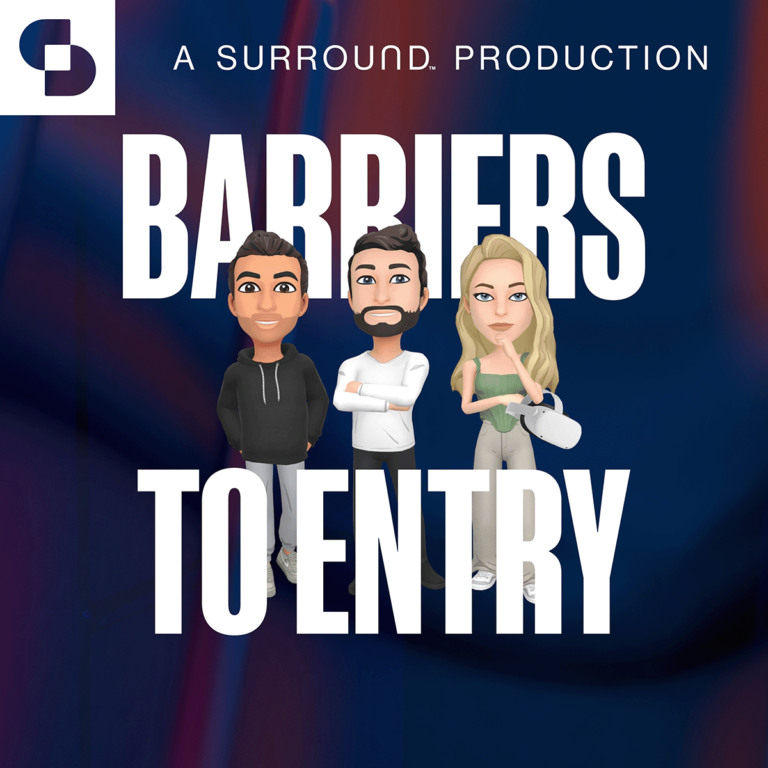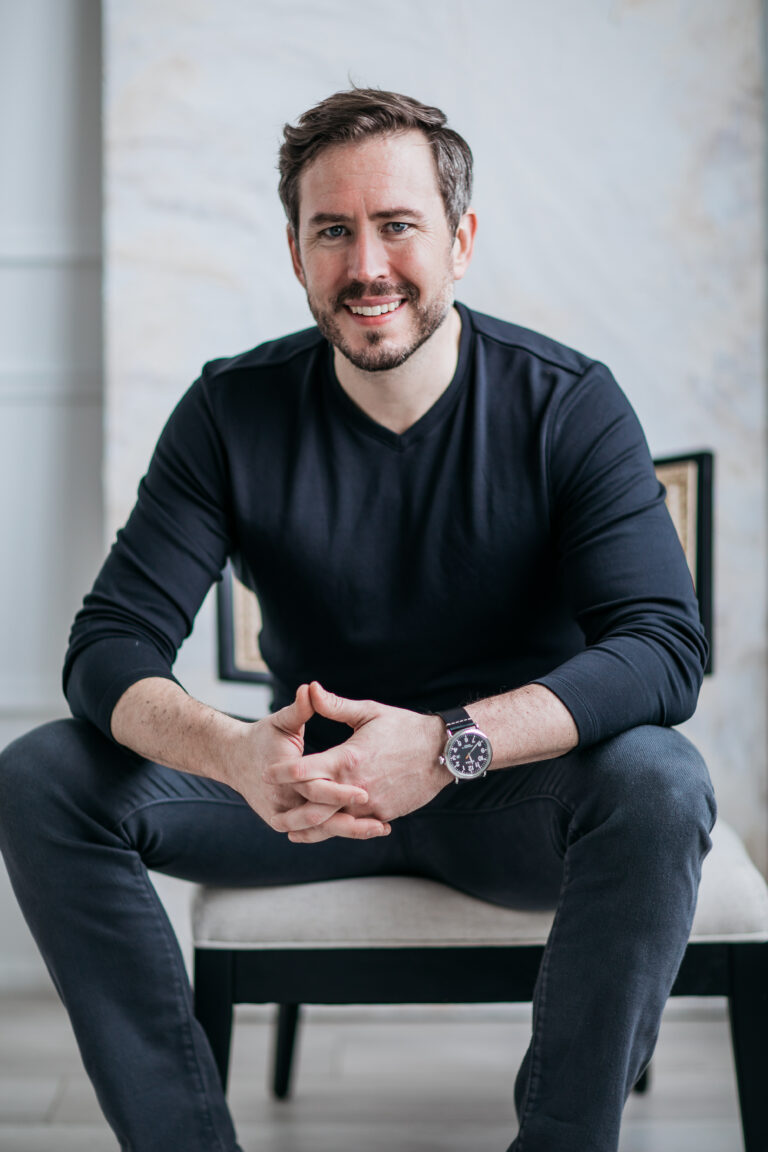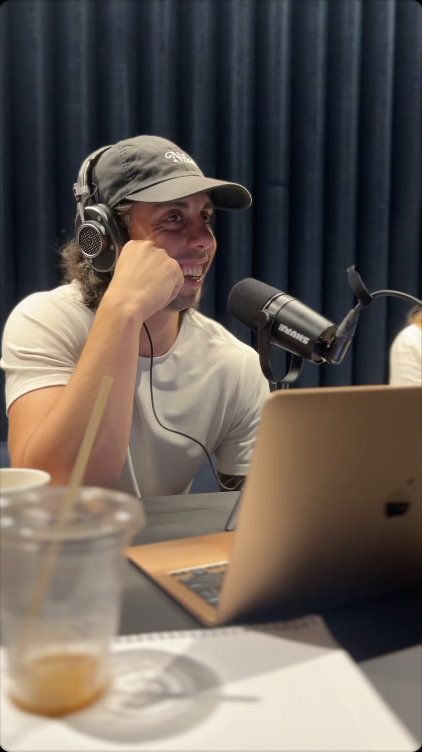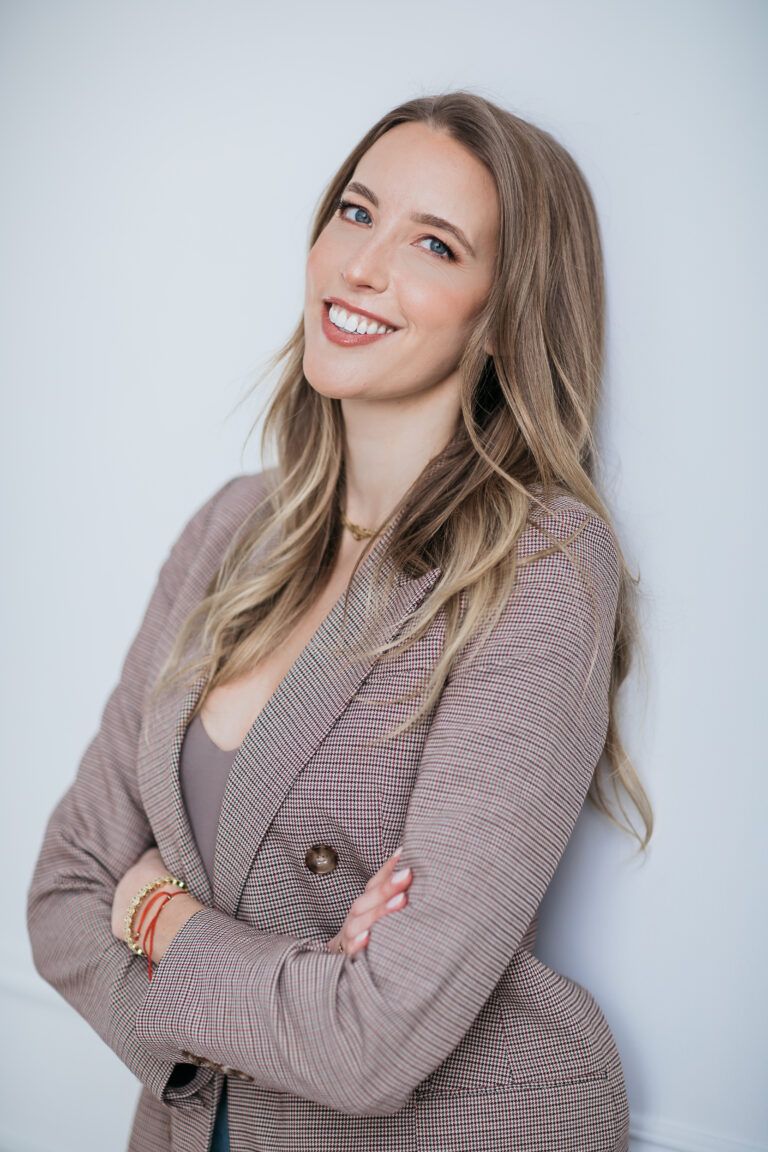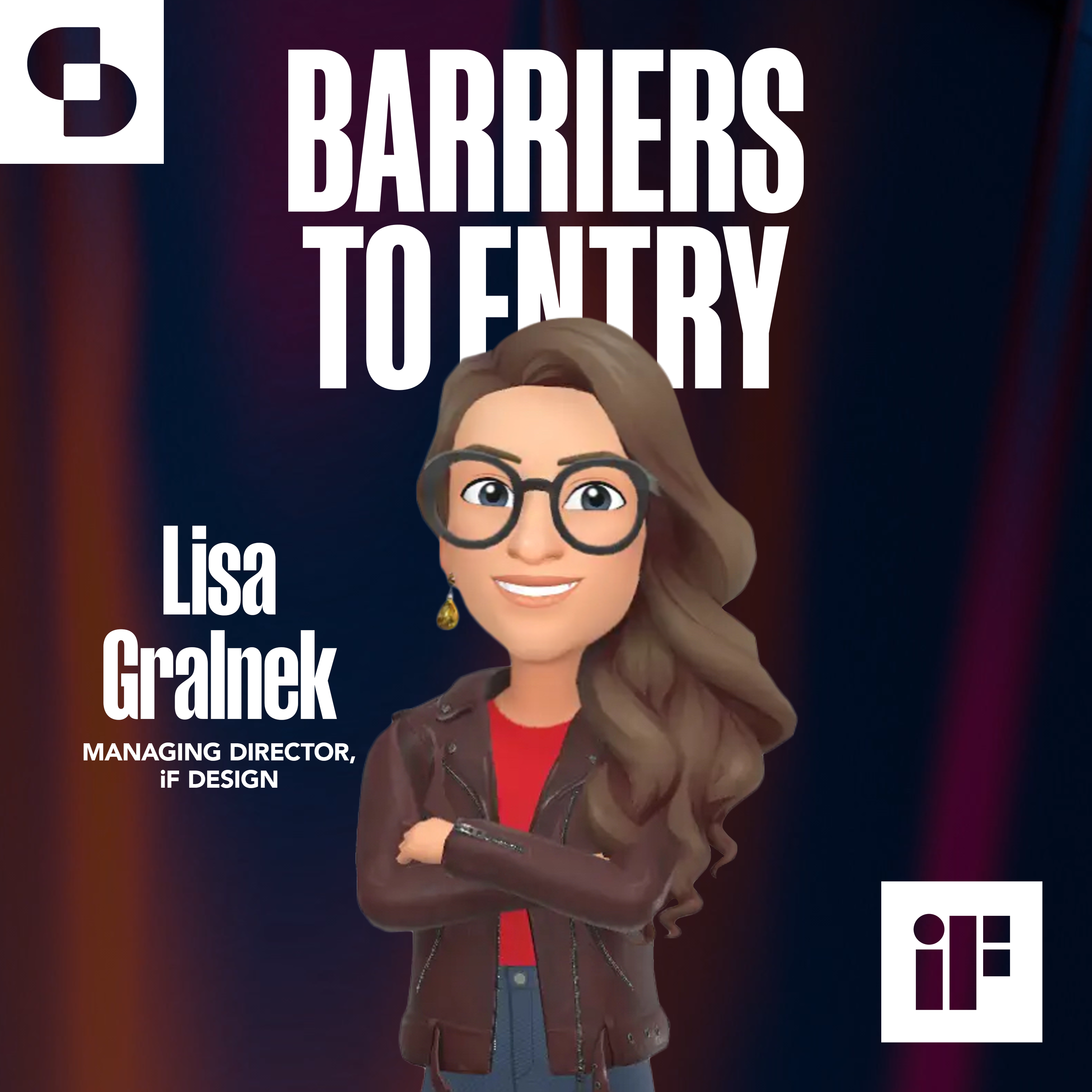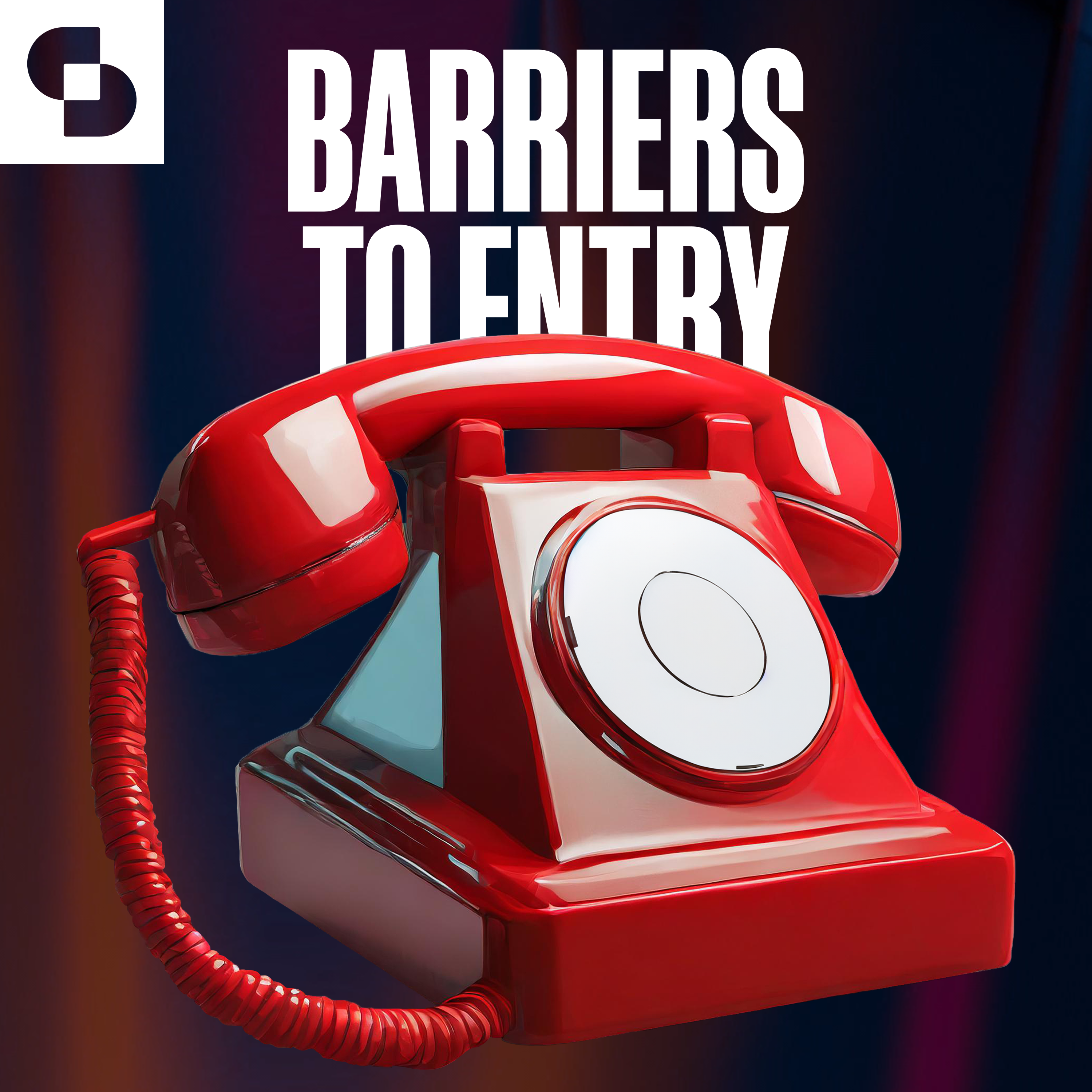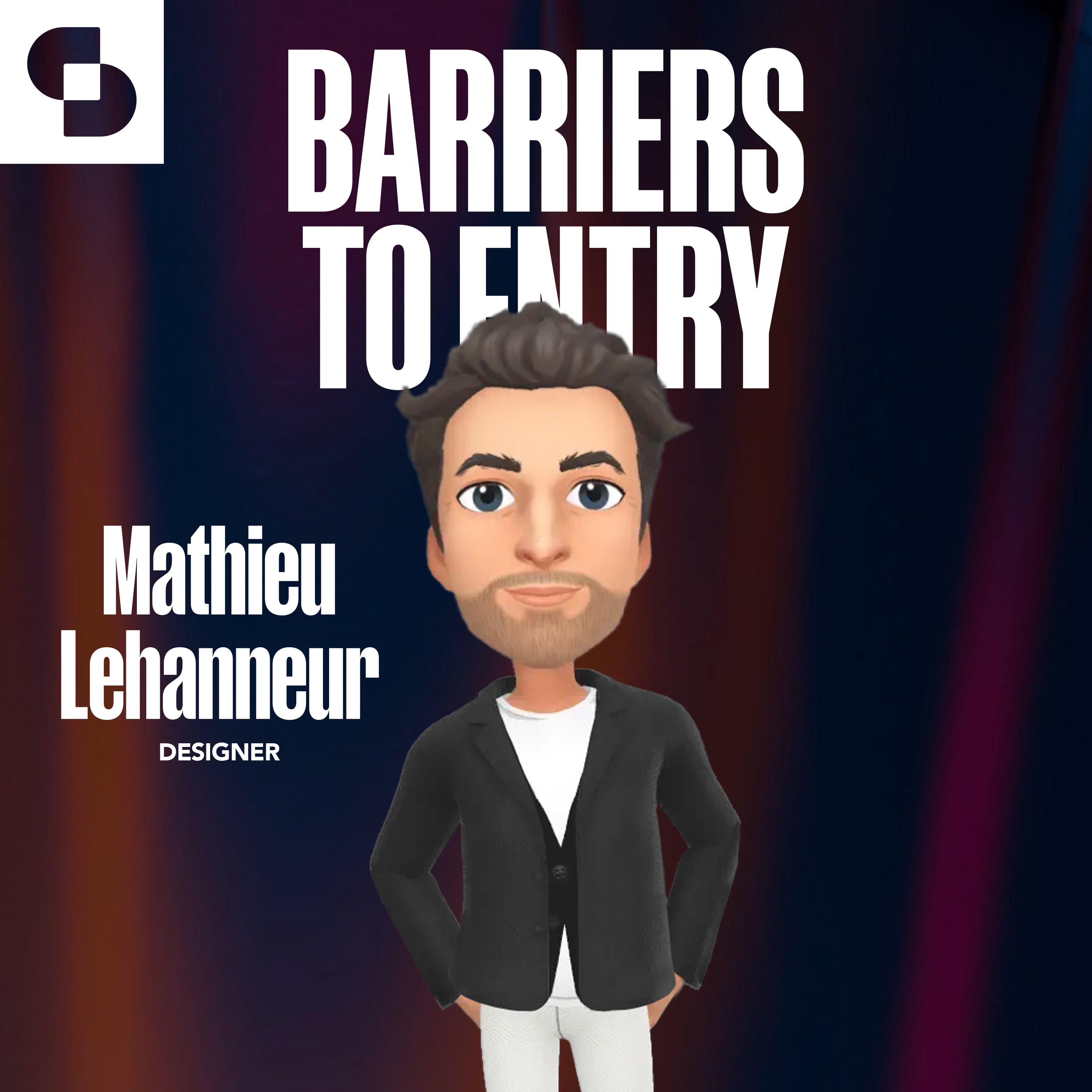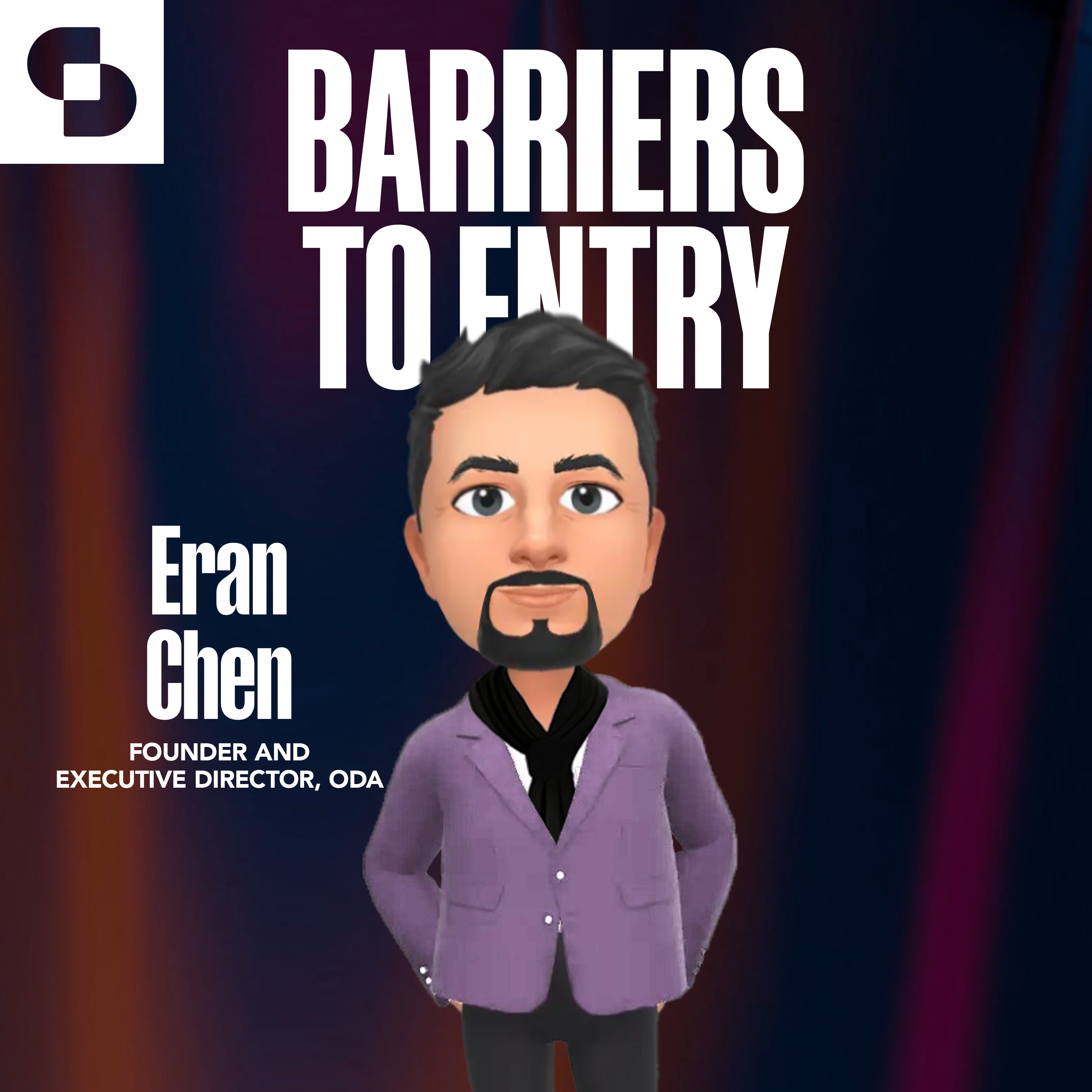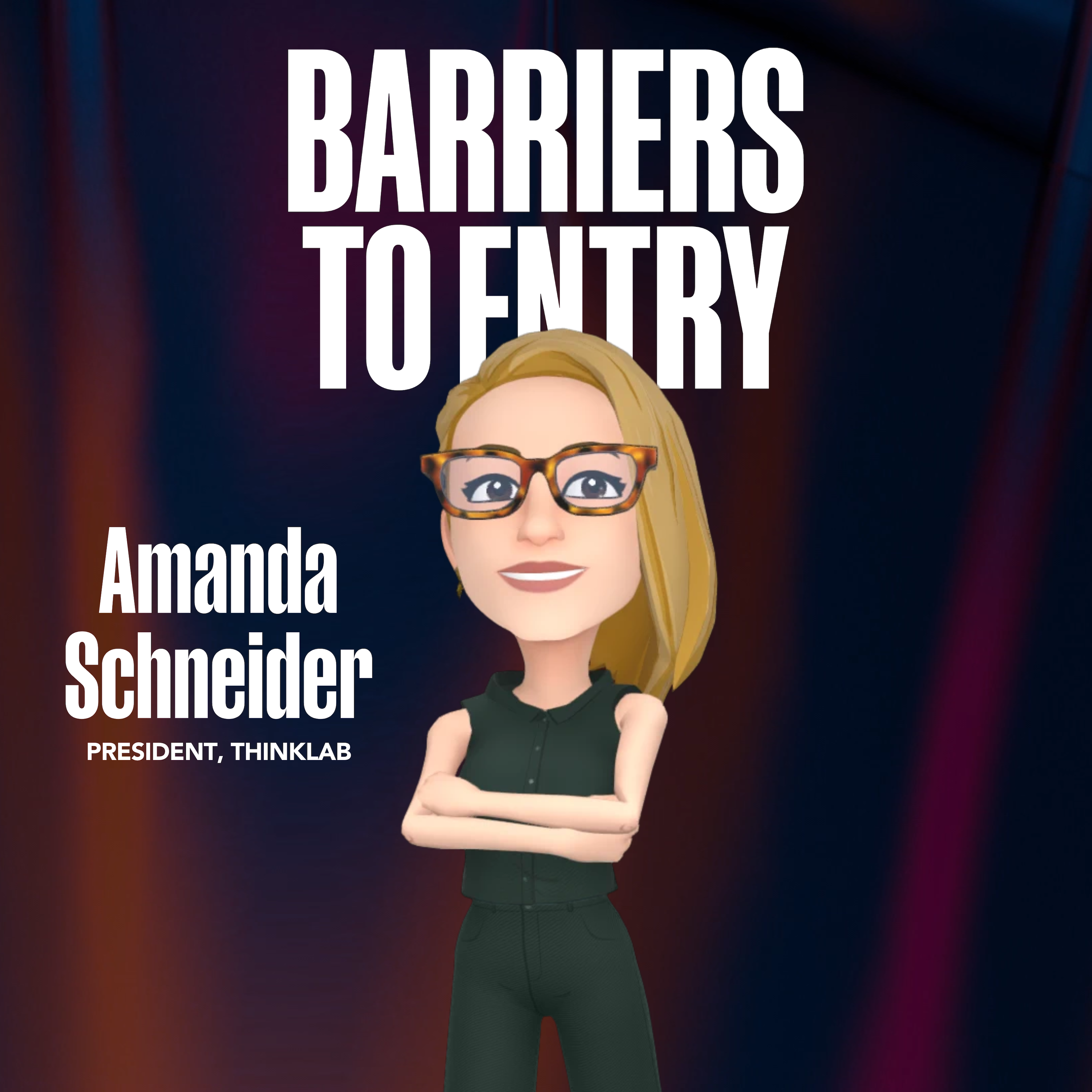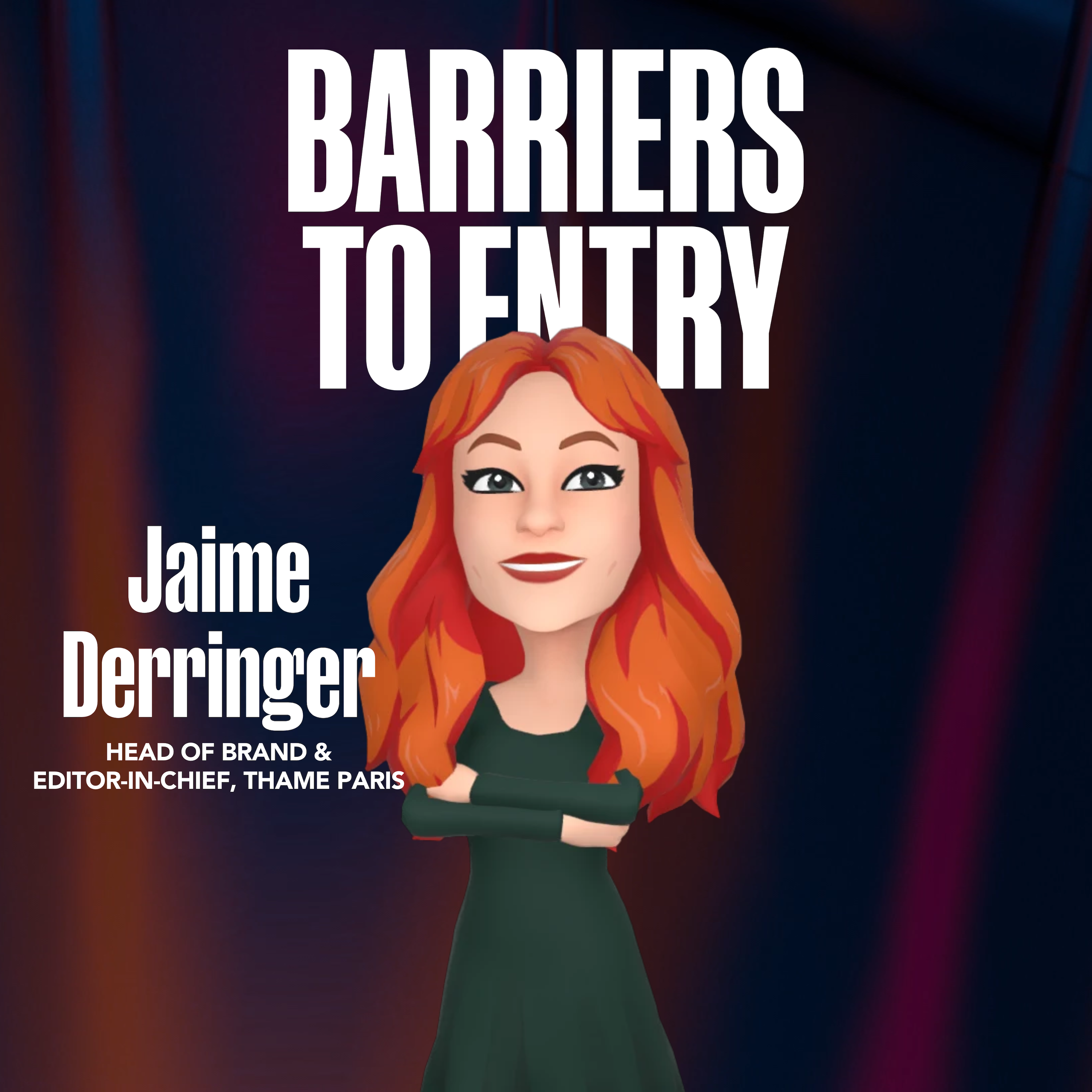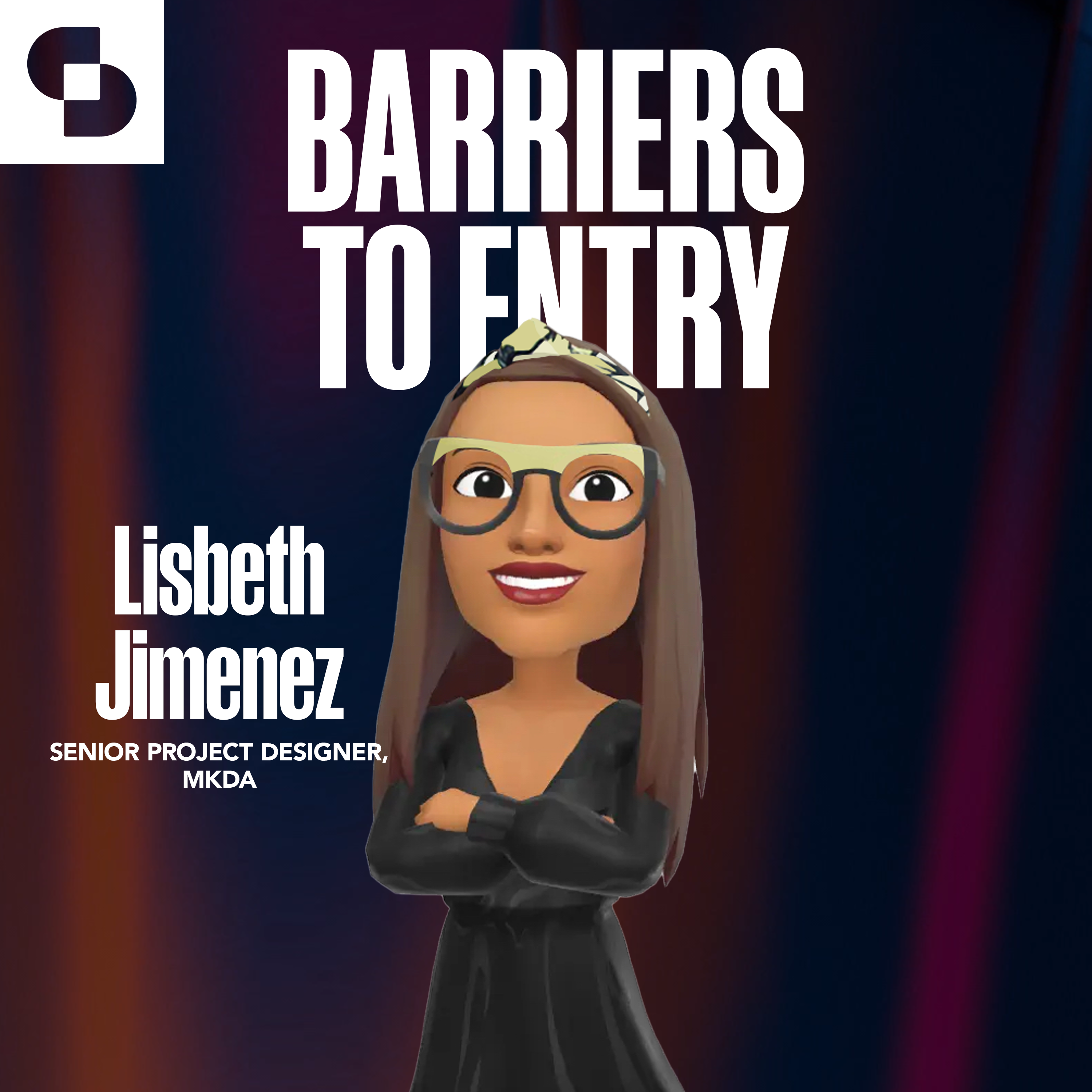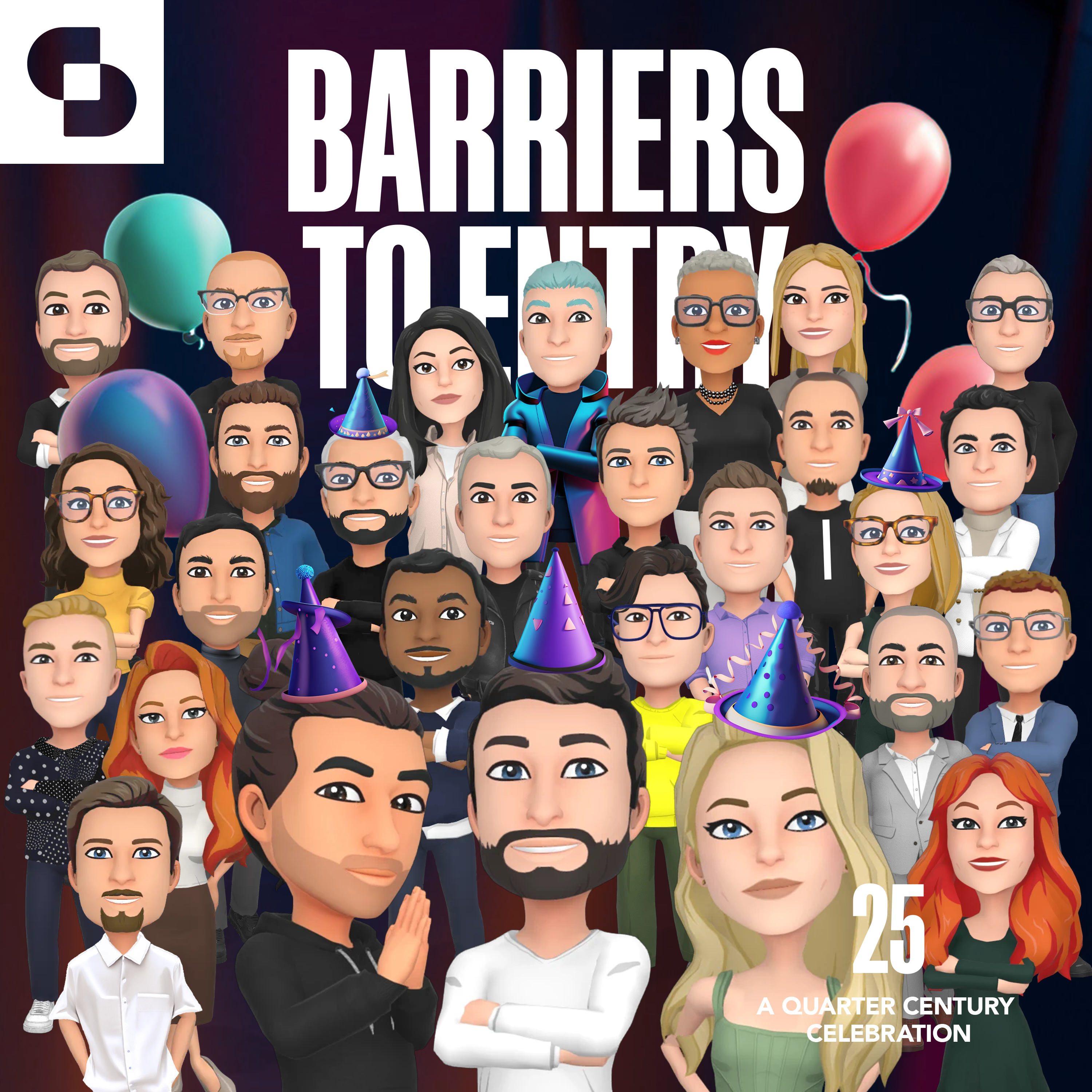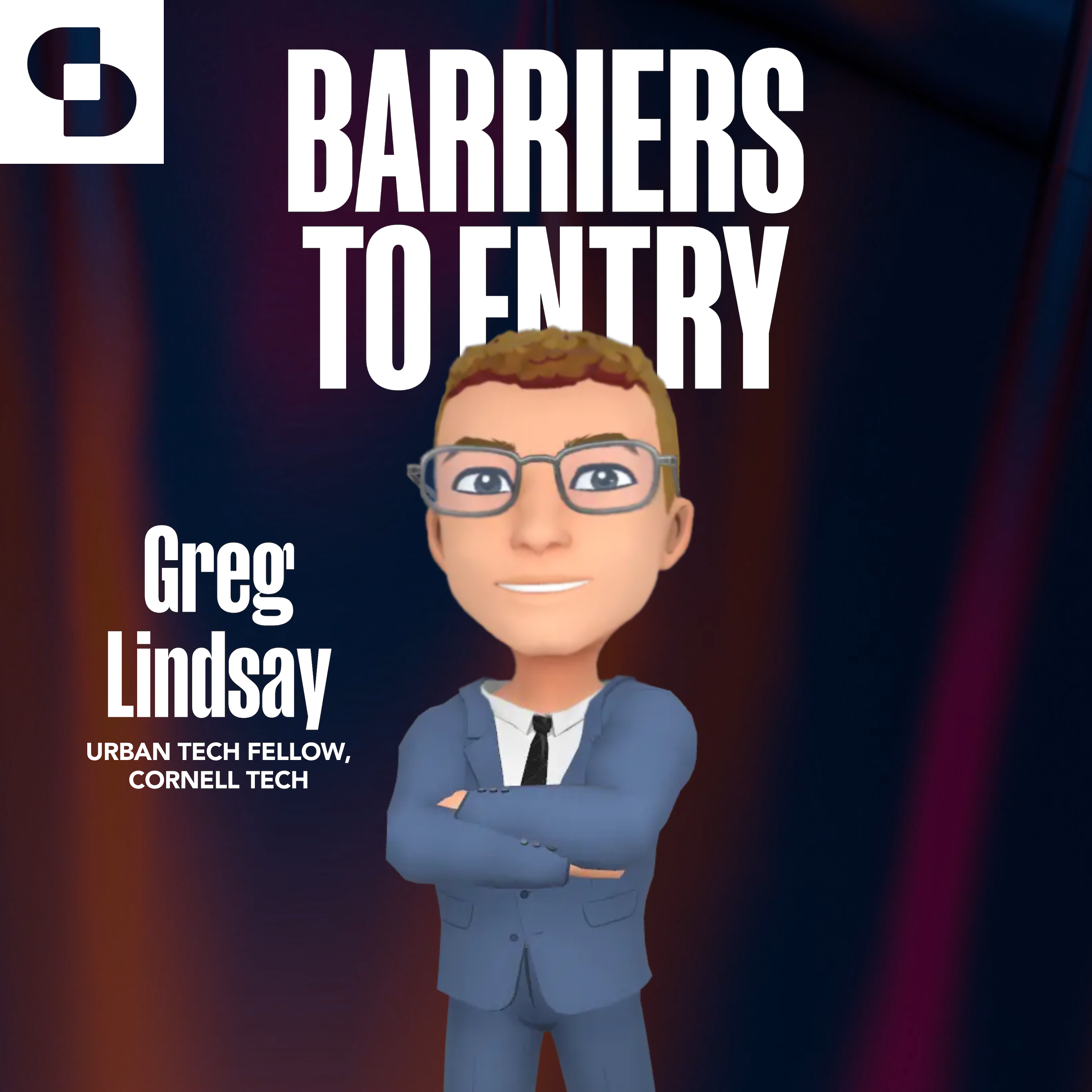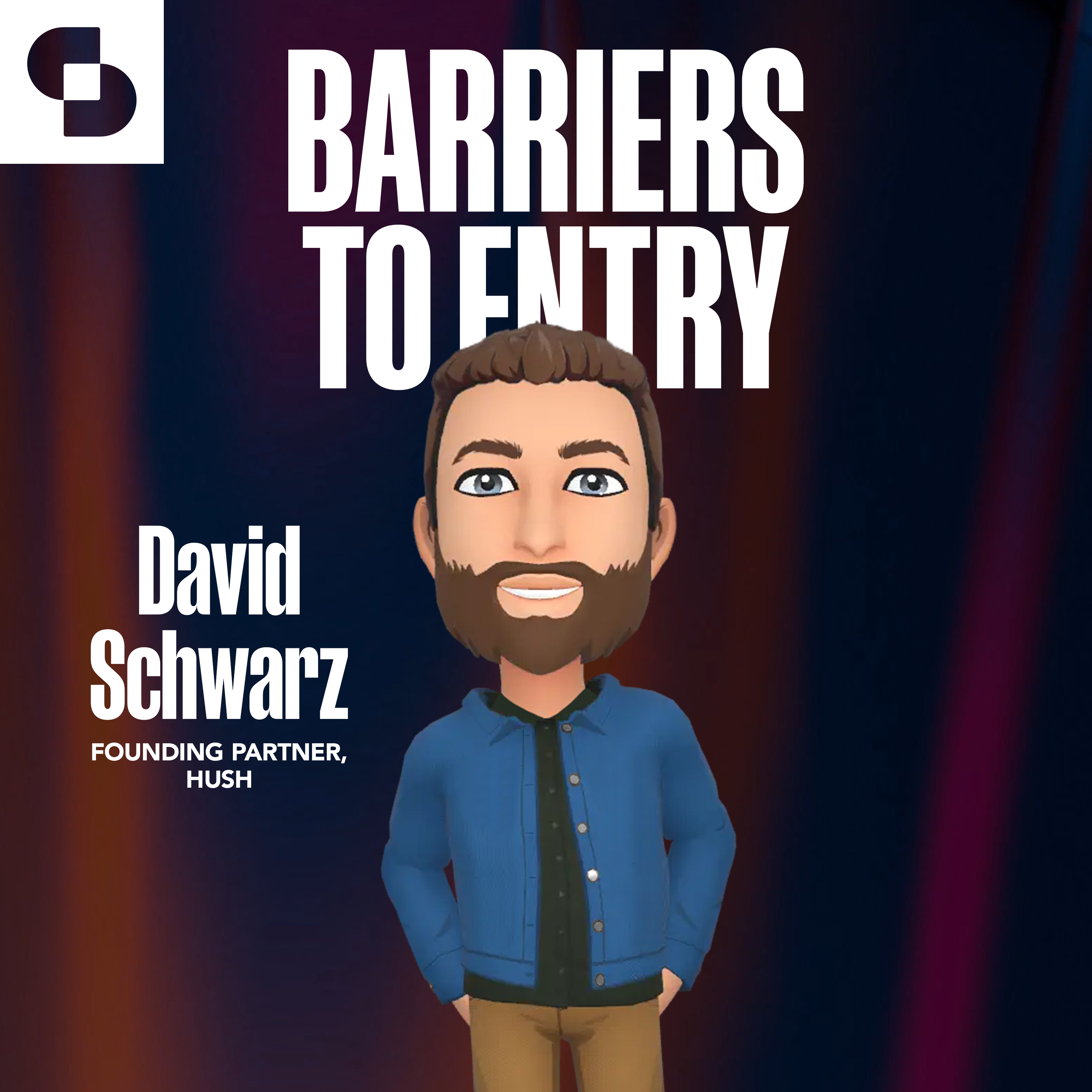Immersive design: by Gensler.
This week we welcome one of the leaders of a rapidly growing practice area from one of the world’s most noteworthy architecture & design firms, Gensler. In a can’t-miss conversation, Sarah DiLeo, our first guest who can claim to be both a member of the Academy of Television Arts and Sciences and a licensed pilot, goes deep with the gang into how a leading immersive media practice is thinking about technology, talent, inclusive design, and more. All this while we lose Bobby to the vortex of the internet, attempt to transform Sarah into a Swiftie, and reveal Andrew’s ideal location for podcast listening. You’ll want to immerse yourself in this one.
Connect with Sarah DiLeo on LinkedIn!
Moments to check out:
- (5:43) Connecting emerging practice with ongoing client requirements
- (16:19) Designing the ‘Metaverse’ vs Immersive design
- (24:48) Creating inclusive, immersive design
- (30:43) Applying AI and emerging tech for inclusive design
- (34:23) Building teams that work on the leading edge
Connect with our hosts on LinkedIn;
References and resources:
- Gensler
- Gensler Digital Experience Design
- Gensler Research Library
- Gensler blog: Strategies for Immersive Design
- Gensler blog: Driving Inclusivity in Digital Content
- Swiftie
- Meow Wolf
- Sphere Las Vegas
- Disney Imagineering
- Yayoi Kusama’s Obliteration Room
Related and Referenced BTE Episodes:
This episode of Barriers to Entry was produced and edited by Wize Grazette and Rob Schulte.
Sarah DiLeo: [00:00:00] I don’t think we’re trying to use, you know, tech for tech’s sake ever. Um, again, it really goes back to, you know, tech is a tool to achieve an experience goal. Um, and that technology, you know, digital technology happens to be our toolkit. We’re never technology first. So when I think about AI, I think the same thing applies.
Sarah DiLeo: It’s really how do these, you know, this set of tools allow us to tell stories in a new way that’s interesting to us. Welcome
Tessa Bain: to Barriers to Entry, the podcast where every episode we get into it with the leaders, the designers, the early adopters, and the influencers who are driving innovation in the architecture and design industry.
Tessa Bain: It’s the Metaverse, it’s AI, it’s blockchain, and it is all happening here. I’m Tessa Bain, and as always, I’m joined by my illustrious co hosts, Andrew Lane and
Sarah DiLeo: Bobby Bounet.
Andrew Lane: I feel like illustrious is [00:01:00] your go to adjective, isn’t it? Have I not said
Sarah DiLeo: that before?
Andrew Lane: I just think that in life, in general, you just…
Andrew Lane: Okay, I
Sarah DiLeo: thought
Tessa Bain: you were calling me out like I’ve used that on the pot
Andrew Lane: already. No, I think you just love that word, and I love being called it, so, I don’t know. Bobby, are you feeling illustrious? I’m,
Bobby Bonett: I would bet a dollar that Tessa’s used that before.
Andrew Lane: Oh no! Have I actually? We might need to go into the archives, we’ll have to check in with the production team on this.
Andrew Lane: Someone call the producers. But it seems like it might be likely. So I think that uh But we have an archives now.
Bobby Bonett: This is year two. Year two glow up.
Andrew Lane: Here we go. I know, right? We’re totally glowing up. Episode twenty six? Year two, summer of BT long in the rear view and super exciting guests today that Bobby, you were not able to join us for quite a bit of, I don’t know if we can summon Rob Schulte, producer Rob Schulte to talk about what happened there, but maybe you want to give a summary for your absence to the viewers.
Andrew Lane: I’ll just
Bobby Bonett: say very quickly, we remote produce barriers to entry about 80 percent of the time. This was a [00:02:00] remote produced episode. And my mesh network at home failed me, so I was on for the first two minutes and then I disappeared due to an internet failure. But here we are and I’m excited for our Halloween episode today.
Bobby Bonett: The Halloween theme ends right now, but we’re going to get into it with Sarah DeLeo from Gensler. She’s leading up the DXD program at Gensler and learned a lot about storytelling led design today, which was a conversation I was really excited to listen back to and I know our listeners are going to enjoy as well.
Andrew Lane: And maybe you’ll even surprise the listeners with a little guest appearance towards the end, Bobby. Let’s see. We’ll see.
Bobby Bonett: We’ll see. Cool. Let’s get into
Andrew Lane: it. Today on the pod, we’re excited to welcome a true storyteller who’s now using her experience as a filmmaker and virtual reality producer to redefine experiences at one of the world’s largest design firms while passionately advocating for inclusivity in all she does.
Andrew Lane: Today, she is the co studio director of Gensler’s Global Digital Experience Design Group, leading cross functional professionals to create leading [00:03:00] edge experiences for the firm’s top global clients. And to put a cherry on top, she might be the first ever guest on Barry’s Sentry to have two distinctions.
Andrew Lane: She is both a distinguished member of the Academy of Television Arts and Sciences. As well as a licensed pilot. Please welcome to the pod, a woman of many talents, Sarah DeLeo. Welcome,
Sarah DiLeo: Sarah. Welcome. Lovely to be here. Thanks for having me.
Tessa Bain: So Sarah, you work in the world of design today, but you came to your role at Gensler through a pretty non traditional path.
Tessa Bain: Can you tell us a little bit about the role of storytelling in your work and how your career before Gensler prepared you for what you do
Sarah DiLeo: today? Sure. I think that I’ve had a very multidisciplinary and maybe circuitous path to where I am and what I’m doing now. But when I look at everything that I’ve done, like the through line for me is always that I’ve spent my career as a storyteller.
Sarah DiLeo: I began fairly early, you know, really in childhood, even as an analog photographer and a creative writer and eventually, you know, grew into a filmmaker. I went to film school and that was my formal training and I [00:04:00] ultimately became a producer. Producing stories across a variety of media and platforms from cinema to advertising to experiential installations and virtual and augmented reality and now working in the built environment with a focus on immersive experience.
Sarah DiLeo: I’m relentlessly curious and I love learning new things and solving hard problems in new ways. And most of all, I love finding a way to tell a compelling story and make people feel something. Sarah,
Andrew Lane: your group, the Digital Experience Design Group, is something that’s really integrated across all the work at Gensler.
Andrew Lane: Can you talk a little bit about kind of how something that’s that cross functional comes into being in such a large and disciplinary, interdisciplinary group? And I know this predates you even a little bit. Maybe you can take us back in the lore a little bit of how this came to happen.
Sarah DiLeo: Absolutely.
Sarah DiLeo: Gensler is obviously a highly respected global architecture and design firm and has been around for many, many years, has an [00:05:00] incredible legacy. And over its 50 plus years of history, the firm has always. It’s grown by expanding its capabilities and services across many industries. It started actually as an interiors firm and then grew into architecture and over time started providing more strategic services and research and brand, now sustainability consulting and DXD or digital experience design is one of many.
Sarah DiLeo: Of those newer services and capabilities that, uh, like all of the others that have been added over time are really driven by where the industry is going, where we see the world going generally, and, you know, ultimately what our clients expect from an integrated design
Andrew Lane: firm. So when you’re thinking about like where DXD is going, like, what are you thinking about to keep up with that?
Andrew Lane: You know, you say it so casually, we’re just where the world’s going, but obviously that’s something that’s tricky to put your finger on the pulse
Sarah DiLeo: of. I think it’s very meaningful that DXD. grew up organically within Gensler [00:06:00] and isn’t a separate team or a separate capability that was gained through acquisition.
Sarah DiLeo: Um, as it is for some other companies, you know, we really grew organically out of a team doing brand expression, brand storytelling, and eventually as the world. trended in an immersive and digital direction. A lot of that expression they found, you know, having immersive and digital components. There’s a lot of complexity and specialization obviously needed to execute that work.
Sarah DiLeo: And ultimately this predates me, you know, but they wisely decided it’s kind of a binge business unto itself and brought in leadership to run that business, which is still here today, running the business successfully, but still working very closely hand in hand with the brand and strategy partners inside the firm.
Sarah DiLeo: And I think we work with those folks every day. And really wouldn’t be able to do what we do without those relationships either. So we have this incredible advantage of being part of this very large firm with established [00:07:00] capabilities in all of these other areas that are also essential components of instilling a successful digital activation built environment.
Sarah DiLeo: We’ve Gensler to scale along with the needs. and desires of our clients. So, as we’ve had this wonderful growth trajectory over the past several years of DXD’s existence, that’s gone in tandem with the scale, the volume of both our client base, and kind of the ambitions and size of projects that our clients are undertaking.
Sarah DiLeo: Yeah, we’ve
Tessa Bain: actually like started this a little bit of an informal poll. And we’d love to get your thoughts. What do you think about the word fidgetal, number one? What is your opinion on that? And then how does the concept of fidgetal play into
Sarah DiLeo: your work? I’m very curious to see your poll results, and if anyone has voted yes on digital, I’m curious.
Sarah DiLeo: But in these trying times, it’s the one thing we can agree on. Everyone hates the word digital. I think it might be my least favorite portmanteau of all [00:08:00] time, though it has some, some good competitors, but it certainly, you know, obviously it calls out the essentialness of connecting physical and digital design, right?
Sarah DiLeo: And that. There’s plenty of great digital design in the world that’s not connected to physical space, but that’s not what we do here. You know, that, that’s not the, um, the purpose of Gensler and DXT. We’re here to really create unique experiences at the intersection of architecture, interior design, brand, and technology and leveraging.
Sarah DiLeo: Um, technology to activate and connect spaces and engage audiences, even going beyond the time that they spend within that built environment. That’s the key to, uh, I think the success of, of what we’re able to do. So the connection between physical and digital, I think what we’re always aiming for in our design is.
Sarah DiLeo: That that connection point feels seamless and not like a separate layer or a separate channel of an experience [00:09:00] for a person, you know, we don’t want a piece of content or an element of digital design to pull you out of the environment, barring, you know, maybe something where maybe that’s being done for a very intentional reason, but for the most part, we’re really looking to design in a completely integrated fashion and we appreciate it.
Sarah DiLeo: That’s part of the, again, the advantage of being part of Gensler is working so closely with interior design teams, with brand teams, with strategy teams, so that all of those design decisions are being made in an integrated way and not to overuse that word, but that we’re driving towards the same client goals and design goals together.
Sarah DiLeo: And creating spaces that are multisensory and deliver on that physical digital design experience without the person having that experience being aware of that separation.
Andrew Lane: So functionally, you talked about all the people you’re collaborating with, like, how does that work? How is it that you get [00:10:00] brought into these different experiences or these different projects, they should say, how does that actually structurally work inside the firm so that you get to give the input at the right time and in the right context?
Sarah DiLeo: I think that a big part of achieving what you’re talking about, which is what comes before the integrated design process begins, right? How do we actually tee up that process to happen and to unfold in the most successful way? I think. This is not an original sentiment, but it really starts with relationships and trust.
Sarah DiLeo: I think that we’ve been very fortunate to have some incredible collaborators, uh, within Gensler who are leaders in their fields and, you know, subject matter experts in their fields that we’ve been able to partner with and build trust over time, um, that not only Will we deliver something that ultimately, you know, meets the client’s needs and makes the client happy, but that we can come at it from a like minded point of view, that we [00:11:00] can collaborate on design solutions that take both the physical needs of the space and the digital goals into account and you know that we can do that.
Sarah DiLeo: Collectively with excellence. I have a long history of being part of new ventures inside of larger organizations. You know, it’s my sort of entrepreneurial side and
Andrew Lane: Intrapreneurial I think is the portmanteau you’re searching for there.
Sarah DiLeo: Oh, nicely done. All right. I like that. I’m so accustomed to being in roles like that at this point that.
Sarah DiLeo: I really enjoy what I would kind of call the process of winning hearts and minds, you know, that really happens brick by brick. And so I think it requires a lot of patience, also coupled with the helpful impatience of being really ambitious and being bold and having big goals without losing sight of, you know, the ways that you need to build relationships and trust to be able to achieve those.
Sarah DiLeo: And I think that’s true on the client side too. You know, I mean, I actually really enjoy. Client, [00:12:00] like working in client relations, which I’ve done in, in many of my roles and I enjoy solving challenges and I think any constraints that come from clients, whether they’re. logistical or budgetary or time or, uh, any of the above that constraints, you know, for the most part, really do encourage you to just think more creatively.
Sarah DiLeo: And most of the time really appreciate that. So I enjoyed that process too, of, you know, clients are just people. We all, and ostensibly we all have the same goal and we all, uh, they have a lot of knowledge about their. Brand or their company or their need that, that we don’t have as a, as intrinsically and we have knowledge about what we do that they don’t have as intrinsically.
Sarah DiLeo: So we have so much to share with each other. And the process of building trust through sharing that expertise and, you know, using it to make one-on-one equal three is. Something that is really fun for me. Well, I was
Andrew Lane: curious, you talked about [00:13:00] constraints, but can you talk a little bit about what some of these constraints are that, that you might face and like what are some of these things that you collectively need to overcome?
Sarah DiLeo: Yeah, I mean, I think with any work in this industry or anything similar, budget and times, almost always a constraint, right? There’s never an infinite budget, never infinite time. So it’s just a sliding scale of, of how strong that constraint is. Mm-Hmm, , but it’s always there. I’m, you know,
Andrew Lane: it’s good, fast, cheap, and you pick two,
Sarah DiLeo: right?
Sarah DiLeo: You’re lucky if you get to, but I began my career in independent film and of the many gifts I think that formative experience gave me that still serves me today is the willingness to dig in and figure it out. There’s a time period when you’re. I remember in producing a film independently where you’re the, you’re kind of the first person there for a while while you’re out there trying to kind of galvanize, people to be your collaborators and to come on board this kind of crazy train with you.
Sarah DiLeo: And while you’re [00:14:00] out there raising money and before the machine really spins up in earnest and the same thing kind of happens at the end when the machine spins down. And, you know, you’re sort of the last person standing and keep getting, you know, statements from a distributor years later or hearing, you know, some issue that comes up, um, way after the fact.
Sarah DiLeo: But I think the great thing about that is it’s forced me to wear a lot of proverbial hats and. I’m still comfortable doing that. It also, it gave me the experience early on of the existential level necessity of being curious and learning about other people’s expertise and understanding what other people do well enough to be conversant with them about it.
Sarah DiLeo: Because part of the job of a producer is really to synthesize all of that information and. And, you know, use it to make a plan and move forward.
Tessa Bain: So you must have to be really collaborative too with a lot of the manufacturers, [00:15:00] fabricators and things like that. Like I’m sure you’re learning about all new technologies and materials coming out.
Tessa Bain: Yeah. Like that must be a really interesting part of your job because you probably are on the like the forefront of, you know, new materials that are doing something different that a lot of people haven’t heard of. You
Sarah DiLeo: know, I think we have a couple of creative technology directors in our practice who are truly incredible as well as, you know, a number of other creative technologists that support them, all of whom are really incredible.
Sarah DiLeo: We have technology. production team that is also amazing at what they do. And collectively they have very close relationships with, you know, AV integrators, manufacturers, and fabricators that ultimately are hired by clients, but are work we work very closely with to achieve these experiences. And, and absolutely those relationships are crucial to.
Sarah DiLeo: Everything from being able to understand hardware lead times to helping to spec out something to do something with this transparent OLED that [00:16:00] we haven’t seen done before. We have a lab in New York and a lab in LA where we do a lot of prototyping and testing. It’s really crucial to our practice as well and we’re lucky to be able to sometimes borrow or utilize those materials.
Sarah DiLeo: Yeah, I’m
Tessa Bain: curious too, like, that’s a lot on, like, physical and built environment. And you know, we talk a lot about metaverse on this show and wondering, you know, if you can speak to So let’s rewind maybe like a year and a half ago when like the metaverse hype was a thing. What were the asks you were getting from your clients then?
Tessa Bain: How has that transitioned into the spaces that you’re building today? Like are you seeing a shift in the type of requests you’re getting from clients from a year, year and a half, two years ago
Sarah DiLeo: to today? It’s very interesting. I mean, I think that there. Has been some interesting work done in the metaverse space from an architectural and design standpoint.
Sarah DiLeo: It’s obviously very nascent. I don’t know that I [00:17:00] felt it touching our work that much. I do think that someone I who you interviewed, I think it was Patty Carpenter, which was Mm-Hmm. maybe of all you guys have had so many great interviews. She might have been. My favorite. It was just an incredible nice shout out for Patty.
Sarah DiLeo: Love that. I
Tessa Bain: was going to
Sarah DiLeo: say, shout out Patty. Yeah, she, she was just amazing. I mean, I also really like the other stand out to me with maybe David Schwartz, just cause we’re in such similar industries. And so it was fascinating to me to hear from him on the kind of challenges and opportunities that I’m very familiar with.
Sarah DiLeo: And I’m kind of thinking about every day. And she’s kind of the opposite. She’s in this field that I don’t really know anything about. So hearing from her, it was really just, it’s, it was so edifying to hear about how she works, how she looks at trends and color and textiles and all of that. And I just also just.
Sarah DiLeo: As a quick tangent, like loved when she was talking about how she can tell the difference between clothing that’s been designed completely by human hand versus using [00:18:00] Mm-Hmm. Casuals or, you know, other computer programs because I am a big, you know, analog photography nerd, and I, I still really hold onto film with that same belief that I can see the difference , you know?
Sarah DiLeo: Yeah, yeah. Totally. Yeah. I, I think it was a, just an important point she was making overall about. It’s reflecting where we are culturally, that people are drawn to things that you can tell are handmade in some fashion, right? Um, maybe that’s a decent segue to thinking about kind of what is the future of the metaverse.
Sarah DiLeo: I thought of her because I feel like she expressed more bullishness about the future of the metaverse than many people do right now. But I kind of think that, and I’ll preface this by saying this is not my area of expertise. So you can, you know, sort of. Discount, whatever, whatever I have to say on this, but I feel like the version of the metaverse that people have ultimately rejected is the version that’s like completely separate from our day to day reality.[00:19:00]
Sarah DiLeo: And it felt analogous to me kind of to the hurdles that I saw in the VR space back when I was producing a lot of VR storytelling, you know, seven, eight, nine years ago, that. Even with very compelling worlds to explore, there’s a very high barrier to entry to convince people to choose an experience that effectively cuts you off from your social
Andrew Lane: framework.
Andrew Lane: I’ve heard it described as the only experience that is fully active active with the exception of being on a roller coaster. Like, when you’re on a roller coaster, the only thing that you’re doing is being on a roller coaster. Exactly. But like, when you’re doing something like listening to our podcast, you’re probably vacuuming, driving your car, like doing any number of other things that would allow you to be simultaneously productive.
Andrew Lane: And you put those goggles on and you get the virtual fishing rod out. As Tessa knows, you’re going to be a, it’s a bit of a call back Sarah. Tessa is an expert, Metaverse Fisherwoman. No, amazing. But you end up in this like, to your point, closed off [00:20:00] space. And Greg Lindsey, a few guests ago was speaking about products and technologies that he sees as being designed to sort of direct reactions to the pandemic, where it’s like, okay, we’re all locked away now.
Andrew Lane: We can’t see each other. So it’s cool if we put these goggles on and Don’t need to interact with anyone else. Cause we’re not allowed to anyways, and that we’re still sort of seeing a hangover from that. And the technology that’s now kind of starting to roll out.
Sarah DiLeo: Absolutely. Yeah. I mean, it felt like a long time, obviously, but in the scheme of things was a pretty ephemeral moment.
Sarah DiLeo: And if anything, people are now sort of like desperately hungry for more communal experience. I see value in virtual worlds beyond the entertainment factor in their ability to really foster agency and that kind of sense of inclusivity in their communities because of that ability to co create and to kind of create these new emergent narratives.
Sarah DiLeo: And really that in, you know, Minecraft, Roblox, whatever, like people really are effectively building these worlds [00:21:00] themselves. And I feel like that’s the most sort of compelling or evocative aspect of virtual worlds in my mind. And it’s not, you know, the brief novelty of people like. Going to the metaverse bar to have a meta drink with meta friends, the
Andrew Lane: meta cocktail.
Andrew Lane: Yeah. Never. Yeah. So sweet.
Sarah DiLeo: Right. But it’s easy to see why for most people they’re never going to do that. And even early adopters. And I think the novelty of that probably wears off. But for worlds that have the ability to evolve. Just as our world does and for worlds that allow their users the ability to, you know, at least Navigate much less to kind of co create what they are that feels like it has huge potential Yeah,
Andrew Lane: no spaces that are purpose built to write like the things that your team is building aren’t necessarily metaverses but they’re you know encroachments of digital into a physical world that serve a purpose and That create a moment that tell a story like I think that that, [00:22:00] you know, we talked about in the pre call is like small and metaverse is just this idea of these more immersive experiences that are creeping into our physical world all the time.
Andrew Lane: And even when you see the way Apple has kind of reacted to everything that meta has been doing, you start to see that immediately is it’s really about the confluence of the two. And here we are back at Fidgetle.
Sarah DiLeo: Yeah. Well, you know, we could go back to maybe just calling this shared experience. Like, I think that a lot of what we’re starting to see emerge as really popular, like even, I don’t know, think about kind of the, the popularity of.
Sarah DiLeo: It’s like Taylor Swift at tour, like part of that insane popularity in my mind, maybe this is because I’m not a Swifty, but like, I think it can be. You’re not allowed
Andrew Lane: to admit that you, you can’t say that
Sarah DiLeo: it’s not. If you just [00:23:00] repeat
Tessa Bain: after me, I am a Swifty. I bet you will get thousands and thousands more listens.
Andrew Lane: Literally half the NFL have come out to be Swifties now. I don’t think it’s impossible. It’s impossible to not be one now.
Sarah DiLeo: I know. I feel a little left out. All right. Well, one week. I’m going to go do a long list of Taylor Swift songs like you’re like, I think that was, was that Bobby’s daughter? Yeah. Yeah.
Sarah DiLeo: I’m going to give Alexa commands and hear them all. Maybe I’ll turn into one by the end of the day, but you know, just saying, even for those of us who may not be tapping into, you know, being a fan, I feel like the, the popularity of that tour to me is somewhat explained by. People’s clear desire to share their love for something with other people who love it, too.
Sarah DiLeo: And, you know, I think we used to, a lot of people used to find that in the movie theater, and that is obviously been waning for a long time. But I think this does underscore, this is like really where I’m very bullish. It’s the importance of unique real time experiences [00:24:00] that are shared with other people, you know, communal experience.
Sarah DiLeo: You know, if we look at TV, for instance, you know, TV is way better than it was 30 years ago. I think most people would probably say that, but it’s also much harder to. community around the shows that you watch? You know, it’s like, every one of us as a party has people telling you like, oh, you should really watch the show.
Sarah DiLeo: And it’s like, everyone has a show they want to recommend to you because there’s thousands of shows and nobody can watch all these shows. And it’s not like, you know, when everybody galvanized around watching the finale of Seinfeld or something. And so there’s people I think are seeking that. That kind of communal, like, sharing of the love for something in other places and, you know, look at Sphere.
Sarah DiLeo: Like, look at Meow Wolf. Look at Disney World! It’s an easy example. Ultimately, there’s a need that people have to share that even with strangers. So
Tessa Bain: when you’re creating these shared experiences in these types of spaces, I know one of the things you’ve mentioned before is you’re incredibly passionate about creating inclusive and immersive design.
Tessa Bain: Can you share a little bit more about that? What does that mean to you [00:25:00] specifically? Sure.
Sarah DiLeo: Yeah. Obviously, as I’ve just been kind of banging on about, you know, I feel like communal experiences are really impactful in physical spaces and in virtual spaces. And I think it’s safe to say that our team of
Sarah DiLeo: Um, and we’re doing that with this internal mandate to design for inclusivity and certainly for accessibility. But sometimes I think that can translate to democratizing access, which is also very important. What I’m really interested in is extending that beyond into authentically inviting in a diversity of users.
Sarah DiLeo: And really look at experience design from this mission of building inclusive communities. And I think that. That really kind of unlocks the, the deeper power of what [00:26:00] immersive experiences can achieve. I think inclusivity is obviously a term that has myriad implicit meanings. And, you know, without kind of going down the rabbit hole of that, I just say when we talk about inclusivity in the context of immersive experience, we’re contending with a wide array of considerations from physical abilities and geographic locations, technological proficiency, gatekeepers, access, identity, there’s all these different matrices for inclusion.
Sarah DiLeo: And I think we believe, and we’ve found through our research, that navigating those considerations with sensitivity and intention is really key to achieving successful engagement. building a diverse audience. Obviously there’s a lot of different use cases. You know, we create experiences that are open to the public and we create experiences that are closed.
Sarah DiLeo: You know, they’re within, um, a workplace for instance. So I have been lucky to be part of a [00:27:00] team that’s been. Uh, recipient of a couple of grants from the Gensler Research Institute, which is just an amazing, uh, feature that, that Gensler has of a, a really incredible research institute doing amazing breadth of research across topics and, and sectors.
Sarah DiLeo: And two colleagues of mine who I’m happy to credit, I don’t know. Yeah, you can
Andrew Lane: totally name drop. We
Sarah DiLeo: encourage it. My colleague, Nick Hubbard, who is a wonderful content strategy lead and my former colleague, Bonnie Reese, who’s a wonderful strategy director. We teamed up and we did two years of research on this topic.
Sarah DiLeo: Initially looking at factors that drive inclusivity in digital content in public spaces, and then. Kicking a slightly. more narrowing the lens to engagement strategies that support immersion. Um, you know, that, that support successful immersive experiences. Uh, I think one [00:28:00] key observation that emerged from the first round of research was the importance of people having influence over a communal experience and I think in.
Sarah DiLeo: immersive experiences in, in the built environment, this, you know, this has different considerations than it may in virtual environments like, you know, RPGs, like Minecraft, Roblox, you know, whatever, where it’s a little more kind of straightforward how people, you know, build those worlds together, but we, you know, we build kind of responsive experiences.
Sarah DiLeo: and interactive components into a great number of our experiences and thinking about how we engage people in being part of the experience and how we can ensure that everyone feels like the experiences for them has been a big [00:29:00] priority. I think a great example of this. It’s in our actual work that I could talk about is the interactive content wall we created for the Dell Technology Club at the Moody Center, a sports arena in Austin.
Sarah DiLeo: Yeah.
Andrew Lane: And you shared with us some, some content about this, right? We’ll, we’ll make sure to post those articles as well as part of the show notes.
Sarah DiLeo: Um, great. Yeah. I think it’s, you know, we, without going into great detail, you know, this is a 60 foot long led covered in, you know, in a. architectural design material that gives it a really interesting look.
Sarah DiLeo: So, you know, it’s not, doesn’t come, it doesn’t present as a screen per se. It’s really, it’s kind of going back to what I was saying before that the notion is that this is blending into the design of the space and becoming another design feature of the space. But we have tracking cameras, sensors that are part of the installation that allow in different modes, the generative imagery.
Sarah DiLeo: on the LED to respond to the movement of [00:30:00] people who are passing by. And there’s all these different modes that can be flipped for concerts versus sports. You know, there’s branding for the UT team that plays there. There’s, there’s different ways to engage with different communities and different use cases.
Sarah DiLeo: But the very basic element of it is you
Sarah DiLeo: Um, and it’s so crowd pleasing, you know, people love it. It also has very low barrier to entry, which I think is, you know, is kind of an important piece of that too. It’s
Andrew Lane: kind of how we got the name for
Sarah DiLeo: our podcast, right? I love it. I think I’ve used that phrase a few times now. It’s just, you’ve, you’ve picked
Andrew Lane: a good one.
Andrew Lane: Rolls off the tongue. It rolls off the tongue. We also wanted to check in with you. I know you brought this up as a point that you can’t go too deep into, but you’ve been doing some work in AI and design and storytelling, and we’d love to just hear a little bit about how obviously this fast emerging tech and Tess already alluded to that, you know, and you alluded [00:31:00] to the labs that you have that are testing things all the time, but kind of where are you at with AI and what have you been learning and how does that fit into this process that you’ve been, you know, laying out through the conversation so far?
Sarah DiLeo: bold in the ideation, but, but thoughtful in the application. I think our team is really great about that. You know, we work with enough emerging technology that while we’re excited about emerging tech always, you know, right. Like if anybody from Apple’s listening wants to send us a vision pro to play with that, that that’s awesome.
Sarah DiLeo: But I think what’s often more compelling. And if I look at our body of work, what I think I could point to in almost everything that we.
Sarah DiLeo: So, you know, the project I just mentioned, where we took 60 foot, nice LED screen and covered it with this metal grate to create this totally different experience. experience for the person looking at it. That’s not a [00:32:00] typical use, you know, for an expensive led screen, but there’s a lot of that type of work in what we do where we’re really, I don’t think we’re trying to use, you know, tech for tech sake ever.
Sarah DiLeo: Again, it really goes back to, you know, tech is a tool to achieve. an experience goal. Um, and technology, you know, digital technology happens to be our toolkit, but we’re never technology first. So when I think about AI, I think the same thing applies. It’s really how do these, you know, this set of tools allow us to tell stories.
Sarah DiLeo: In a new way that’s interesting to us, not necessarily that we’re telling a story that’s about AI. So I think we are playing with it and obviously experimenting with what it can do and all of the different tools that are out there right now. We are lucky to be. Working on a really exciting, you know, really cool [00:33:00] project that I unfortunately can’t say too much about,
Andrew Lane: but this happens to us every week.
Andrew Lane: Don’t worry
Sarah DiLeo: where it is a really, it’s a fundamental part of the system that we’ve designed, but you know, it’s a tool being used by a designer rather than function unto itself. And I think we’re utilizing it in this very interesting, almost kind of poetic way where we take the. Somewhat, you know, kind of dreamlike interpretive quality that the AI image generation tools seem to have and we lean into it and play with that and then we build other tools around it in a robust system that allow for the necessary levels of predictability and content moderation and design QC and so forth.
Sarah DiLeo: But that’s generally speaking, I think with any creative team, there’s a ton of excitement around, you know, a new tool that can potentially enable us to express ourselves in new [00:34:00] ways, but not that the tail is wagging the dog, you know, more that we, if anything, the experimentation we’ve done has really proven out to me and to our team.
Sarah DiLeo: I think just how essential the skilled human designer is.
Andrew Lane: So I’ve got one last thing before we, we let you go here, you’ve talked a lot about different roles, you know, creative technologists, content planners, designers, you know, all sorts of different types of talent that are at the table when you’re building out some of these creations, what are some of the things that you’re doing as the co head of the studio to engage such a diverse group of talent and how are you thinking about that?
Sarah DiLeo: I think we’re doing a few core things that, um, set our team up for [00:35:00] success. We, we organize around disciplines, not around. You know, geography or seniority or, or we have project teams, obviously, but our, our core organizational principle is around disciplines of, of strategy, of design, of technology, of delivery, you know, sort of encompassing production, project management, all of our folks within those are subject matter experts, of course, and, and bring, you know, the necessary rigor to building these experiences for permanent built environments.
Sarah DiLeo: And, you know, our CTs, creative technologists really keep us rooted in what we can actually physically achieve, what we can make happen from an interaction standpoint and, and otherwise through our custom software development and our designers who work very closely with the architectural and interior designers to create.
Sarah DiLeo: experiences, as I’ve mentioned, are fundamentally integrated with the, with the space, um, and the purpose. [00:36:00] I think we have a global approach to staffing our teams. So the reason I think that’s important beyond efficiency is the kind of folks we really want on our team have endlessly curious minds, you know, are always thinking of new ideas.
Sarah DiLeo: I think they really tend to value getting to work on a diverse slate of projects and to work. You know, for a diverse slate of clients and even purposes, uh, forms and functions. And because we staff folks globally and because, you know, people get to move from project to project and to work with a real diversity, you know, we have, I think around 65 people across four major cities in the U S plus London, plus a couple of cities in Asia.
Sarah DiLeo: That people really get the exposure to a diverse set of points of view. They get to work on a diverse set of projects. And I think that is something that people really value. Not to mention, it ultimately makes all of us better at our jobs. The challenges that are [00:37:00] implicit with that and the ways that you learn.
Sarah DiLeo: Also, the Gensler Research Institute, I think that that is a big part of this kind of culture of design innovation and desire to really put structure around our thinking. You know, even when we feel like we’re doing something successfully. It’s not really enough to just do it well. We want to understand what did we do well, how did we do it well, and, you know, continue taking this, this really rigorous approach to looking at ourselves and individually and collectively and being kind of on a permanent path of improvement.
Andrew Lane: It’s amazing. All right, everyone. And through the magic of audio, we’ve actually been able to locate and have Bobby rejoin us. Because if you wouldn’t know it, it’s time for some plugs. And I know Sarah’s got a few cool things to talk about. We would not want to tee this up without having Bobby here to join us.
Andrew Lane: Welcome back to the
Bobby Bonett: thing. If you say the word plugs three times and click your heels, I appear Sarah and I [00:38:00] got a chance to catch up over the weekend in between. When Andrew and Tessa interviewed Sarah and today, and so I’d love to hear you talk a little bit, Sarah, about what you and DXD are focused on as it relates to the experience economy for the plug section and anything else that you’ve got going on.
Bobby Bonett: With you and the Gensler
Sarah DiLeo: team. Absolutely. Yeah, indeed. My plug really is for the experience economy as a whole. I think, you know, immersive experience to me is the most exciting form of storytelling happening in the world right now and beyond even what we’re already seeing, I think this field is poised for exponential growth.
Sarah DiLeo: We talked a lot in our conversation here. about how digital and immersive are permeating the physical spaces where we live, work, and play. And what I’m seeing across our clients at Gensler is that they’re really tuning in to the unparalleled impact and importance of experience, be it for their customers, employees, clients, visitors, patients, et cetera, and looking to bring particularly digitally driven immersive [00:39:00] experience touch points into their built environments.
Sarah DiLeo: I think alongside that, we’re seeing placemaking becoming a high priority across Lifestyle sector and beyond and for DXD for our digital experience design group at Gensler That’s been really incredible news because as we’re seeing this evolution happen across a wide array of sectors We find that our work is applicable to pretty much all of them and we’re designing and building immersive experiences across workplace mixed use retail cultural institutions and museums aviation hospitality health care etc and We’ve also developed an expertise and kind of specialization in this expanding sector of experience centers or innovation centers, which a lot of our workplace clients are creating and dedicating to these curated user journeys for either select groups of employees or clients or both.
Andrew Lane: Just don’t call it metaverse, right?
Sarah DiLeo: Well, it is sort of like the lowercase M metaverse that we’ve talked about [00:40:00] together, right? And actually a good number of those experience centers or innovation center spaces that we’ve worked on do include digital twins as well. They’re being used in really interesting ways, maybe for more kind of qualitative purposes than we may typically think about digital twins.
Sarah DiLeo: But yeah, there is a lowercase M kind of metaverse aspect to this that’s quite interesting. And the other trend that we see within all of that is the need for spaces to, you know, be multimodal, you know, to be more than one thing to more than one community, whether that’s an innovation center or even certain communal spaces within workplaces.
Sarah DiLeo: And of course, diversification of how space is used in retail and hospitality, you know, another way that I think about. So, our approach being flexible and nimble, again, across these sectors, but it’s kind of a different matrix to look at, is scale. You know, we often are working at building scale, obviously, [00:41:00] but we just as easily work at district scale.
Sarah DiLeo: I think one of the most incredible projects I’ve gotten to be involved with here is for the AT& T Discovery District in Dallas. Gensler completely… redesigned this mixed use campus for AT& T and turned it into, you know, not only an amazing lobby in their workplace that has this beautiful, immersive media environment, but an incredible public space that has, I think, foot traffic of around 50, 000 people a week and, you know, F& B and retail and with a 100 foot by 80 foot, sorry, I don’t know how to translate that into meters for for the Canadians on, but, um, a very large
Andrew Lane: media wall.
Andrew Lane: Everyone has their own AI that can figure that
Sarah DiLeo: out. Yeah, exactly. Uh, we’ll do it in real time. But, a very large media wall that, that wraps the building and, where DXD got to really lean into, you know, building a full kind of run of show entertainment experience and program work from some of the world’s best media artists.
Sarah DiLeo: And, you know, we also even sometimes work at city scale. We write [00:42:00] digital master plans for entire.
Andrew Lane: Um, it’s interesting to hear about work like that because obviously this fear has been such a, such a hot media topic of conversation in Las Vegas. But I mean, you know, you did that for a campus as a part of a project that, you know, obviously wouldn’t get the sort of wide scale consumer acknowledgement or awareness of it.
Andrew Lane: But it’s, it’s just interesting to understand how much of this work is really progressing from so many different channels all the time. So, So obviously another vote for experience economy, just in that.
Sarah DiLeo: It’s so true. And I think while a lot of our work to date within DXD has had perhaps, you know, slightly different purpose than something like the Spear in Vegas, I think the really exciting development that Gensler has made over the past year, and it’s particularly exciting for us in DXD, is pushing into the entertainment space and, you know, themed entertainment is obviously.
Sarah DiLeo: You know, has always been focused on creating these kinds of unique and sticky experiences, and usually at a [00:43:00] significant scale and is seeing explosive growth. We all probably saw that news that Disney is well, maybe facing some challenges on their content library and film and TV side is doubling down on their theme park development investment.
Sarah DiLeo: And, you know, universal is making major moves in this space as well. They recently hired our brilliant former colleague, Molly Murphy, as their new president of universal creative. Great shout out to Molly. And experiences. Molly is amazing and already doing incredible things there. So, you know, and obviously you referenced the sphere, which is, you know, I know a lot of people involved with and is unprecedented in so many ways for all of its, its technology, but also its reach, right?
Sarah DiLeo: And, and how many people it can flow through and the level of exposure that it creates for this type of immersive experience. And I think pushing innovation forward in that way is beneficial to the entire industry. And. And the public response to that space, to me, just continues to inspire confidence that people are really hungry [00:44:00] for these experiences, these, you know, I think I said earlier, like unique real time experiences.
Sarah DiLeo: And Gensler recently brought in Bob Weiss, who is one of the foremost experts in the themed entertainment field. He led Disney Imagineering for many years and has been groundbreaking in this field for decades. And he was brought in to create and lead our new entertainment division. And I think he has It’s the incredible insights of someone who’s not only seen the industry up close over time, but he’s actually had a key role in shaping its trajectory.
Sarah DiLeo: And he speaks so incisively about the necessity of putting story first. Certainly not, not technology first, not process first, and not even kind of the, the designer’s idea first, right? It’s looking at what will give people an experience they’ll remember. and letting that guide all the other decisions. So the form and the function have to follow the fulfillment and ultimately with the goal of making sure that the people who experience this work, that [00:45:00] they feel that the story belongs to them.
Sarah DiLeo: That’s probably a part of why I connect so strongly to that sentiment is it’s really the basic tenet of my own passion for inclusivity and engagement and immersive design. I think. Immersive design is an incredible conduit to creating inclusivity and, you know, creating, engaging, and inclusive spaces.
Sarah DiLeo: And when we give people the opportunity to take ownership of a space. They will grow it, they’ll evolve it themselves. The Yayoi Kusama obliteration room from many years ago, I think, is always a great example of this. I’m a big fan of her work, but, you know, it’s interesting when you just say people stood in line, in New York at least, outside.
Sarah DiLeo: Everywhere. Everywhere, right? It’s been all over. Hours and hours and hours just to pass through for a moment and leave a tiny colored sticker in the exhibit. So, it’s just reflective to me of this basic human desire to interact with. and have impact on our environment along with other people, right? The communal aspect being really important.
Sarah DiLeo: And we want to leave our mark. Great experience [00:46:00] design invites everyone in to do that. However, you know, tangibly or intangibly, it may be within the particular space. And so whether we’re talking about a workplace lobby, an airport lounge, an innovation center, a retail store, all spaces that our team gets to touch with our design thinking.
Sarah DiLeo: Ultimately, when we’re successful, I think the constituents of that space feel that it belongs to
Bobby Bonett: them. I love the tie back to live events experiences. I was just thinking about you mentioned my daughter and Taylor Swift in the interview. I was thinking back to the mass hysteria around Taylor Swift live experiences over the summer.
Bobby Bonett: I mean, we’re really seeing a thirst for folks having those shared experiences in many different ways and thinking about the ways in which technology can augment those experiences is certainly top of mind right now. So well plugged, like you said, Andrew.
Tessa Bain: So, Sarah, we love ending every pod by giving our guests a chance to answer our standard final question, which is always, do you have a piece of advice for our audience or some resources that you would share for someone who’s looking to learn more or just coming across [00:47:00] something like DXD for the first time?
Sarah DiLeo: My primary advice to anyone who’s interested in this field is that There are an infinite number of ways in the amazing thing about nascent forms of storytelling, which for all of the achievements in digital experience design already, it is still, I think, in an exciting way in its early years. But the amazing thing about that is forms of storytelling that are emerging are really open to innovation before like a quote unquote establishment exists, and I think this is held true, you know, through history.
Sarah DiLeo: I come from films, so cinema is kind of my lens and my bias, but I think about the way that cinema was made great over and over again through kind of reinvention by people who weren’t part of the existing power structure. So, you know, whether that’s. in the seventies, in this like heyday of cinema with the auteurs who didn’t come out of the studio system and really completely turn filmmaking on its head.
Sarah DiLeo: And then again, in the nineties, with the [00:48:00] explosion of independent film, creating an alternative to the studio system. And of course, not my milieu, but particularly, but like vine early YouTube. And then of course, all the other forms of social storytelling that ultimately like. Accumulated in TikTok. That whole rubric of storytelling on those platforms was built by those creators that just sprang up in their bedrooms doing something totally different from what else was out there.
Sarah DiLeo: I think in my own career I was, you know, kind of on the front lines of VR filmmaking when that was in the zeitgeist, and I was lucky to, to get that firsthand experience and really see how that medium was kind of transformed into some degree created by people who came from other areas of expertise.
Sarah DiLeo: that had relevance in sometimes surprising ways, like theater and gaming and museums. And that was part of what made it great. So I look at our team at DXD. There is this diversity of backgrounds and diversity of experiences that not only are embraced and I actually think are part of what [00:49:00] is our secret sauce that makes our team so gifted and so effective.
Sarah DiLeo: People come from, you know, anything is. It’s disparate from exhibition design to modern dance to painting to people like me who come from film or advertising and people who, who really have taken a straighter path through architecture and interior design that, and of course, you know, all of our software and development team who have very different backgrounds.
Sarah DiLeo: So it just sort of illustrates the point perfectly that there are myriad access points to this work. And, you know, I know again, just to say, I’m part of, you know, a team of 60 plus people at DxD. I’m part of a large leadership team that drives the business creatively and business wise that everybody on our team is.
Sarah DiLeo: And is driving the success of this work for Gitzler. So I think we need the unexpected people to keep making this work as amazing as it can be. And we probably need people doing things that we don’t even know [00:50:00] exists yet. So if that’s you, give us a call.
Andrew Lane: That’s amazing. I think we always appreciate any chance we can get to learn about the secret sauce.
Andrew Lane: So we definitely appreciate that sharing and thanks so much for, for spending this time with us, Sarah, for regrouping with Bobby to make sure. That we really nailed the plug section, which is obviously part that’s near and dear to his heart, but yeah, we can’t thank you enough for coming on with us and Bobby, I know you missed some of the conversation, but I think you got a great flavor of it there at the end, just in terms of some of the sharing that we had with Sarah and some of the great stuff that we had
Sarah DiLeo: learned.
Sarah DiLeo: I can’t thank you enough for encouraging me. You all were the catalyst in my never having listened to a Taylor Swift song to now having listened to one Taylor Swift song.
Bobby Bonett: I know when I was listening back to the interview, Andrew did the wise thing of making sure Sarah that you amended the record to qualify that you’re a big or an emerging Taylor Swift fan, which was important.
Bobby Bonett: Another thing, by the way, I learned is that Andrew prefers listening to podcasts while vacuuming, which was new to me, but actually my
Andrew Lane: truly preferred my truly preferred if we’re [00:51:00] on the record is well, grocery shopping and Tess was just about to correct you. I know, right?
Sarah DiLeo: Yeah, I
Tessa Bain: don’t think I’ve ever seen Andrew vacuum.
Tessa Bain: He does a lot though, but vacuuming is not one of the things he
Bobby Bonett: does. I have to say though, that exciting to listen to an interview like this in that I think with such a focus on storytelling, this is the type of conversation that resonates or will resonate with anyone, irrespective of whether you’re in the design industry or somebody who’s just a fan of forward thinking and innovative and cutting edge design.
Bobby Bonett: And it’s apparent, I think there was a moment in the interview, Sarah, where you were discussing early pandemic approaches to metaverse and virtualized design. And the way I took that was we were designing kind of backwards a little bit. And clearly what you’re doing and what DXD and Gensler is doing is you’re designing forwards with that storytelling forward approach.
Bobby Bonett: And that’s encouraging and again, very accessible to listen to, I think for anybody who’s a fan of storytelling in general. So it was nice to be able to listen to this. Looking back and even though I had some FOMO missing out on the interview myself.
Sarah DiLeo: Thank you. [00:52:00] I love to hear the passion for storytelling reflected back.
Sarah DiLeo: I think for me, that’s always my greatest motivator and I think the central nugget of what we can give people really makes someone’s day better, make their customer experience better, their patient experience better, their workplace experience better, just by The power of story. Well,
Andrew Lane: I’ll thank you again, Sarah, for joining us.
Andrew Lane: Love to thank at this time is everyone on the Barriers to Entry production team, particular our producers, Wise Grisette and Rob Schulte, who had A big stand in opportunity on this particular recording. And of course, everyone back at the studio by Sandow in the pod cave, pushing the buttons and the knobs and making it all sound great for us.
Andrew Lane: Just a reminder to everyone that barriers to entry is a part of the surround podcast network. So please make sure that you go to surround podcasts. That’s podcast with an S dot com. Smash the follow button, follow along for all sorts of great new conversations coming up as we now move into our second year of Barriers to Entry.
Andrew Lane: And please be [00:53:00] back next time as we continue to break down those barriers to entry. Did we trick them with the time lapse already, Bobby?

